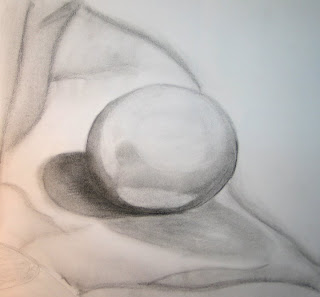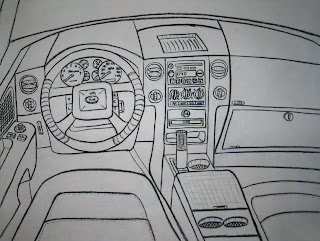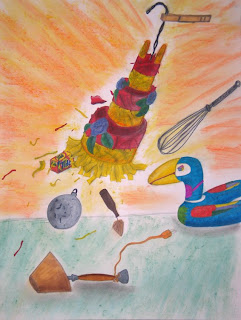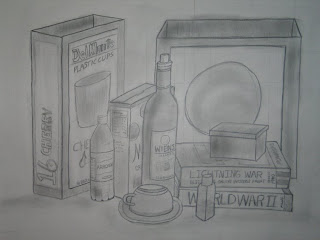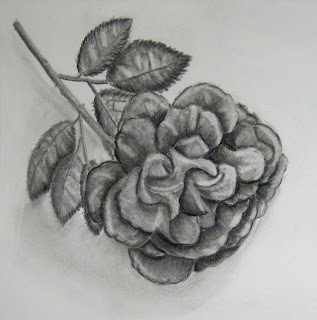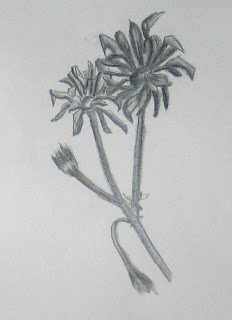
I’m not sure what attracts me to old insulators, but I've always had a fondness for them. They’re easy to obtain and plentiful, but up until today, I’ve only had one, an emerald Hemingray Jason and I found while climbing the mountain behind my parent’s house. I used it as a door stop when I lived at home, and I’ve always had it somewhere in my office; right now, it sits upon my bookshelf, where I can not only admire it for what it is, but it is a relic of my childhood, when finding some strange glass object was like diving on a sunken ship and discovering a treasure chest full of gold.
There’s something about them that attracts me to them. Maybe it’s the combination of the beauty of craftsmanship and the evolution of commerce, or perhaps they are a reminder of progress, a tribute to industry, something that harkens back to a time when connecting the country, joining the two coasts in voice, information and electricity was paramount. In the age of cell phones and underground power conduits, they’re an obsolete artifact of a forgotten time. I doubt the average person on the street would know what they are… but then again, the average person on the street is a moron who doesn’t know much of anything.
Either way, I have about 150 of them now, ranging from small brown porcelain ones up to a five-foot monster, all bought from CraigsList from a woman in El Mirage. Until this morning, I didn’t know where that was, but if you go as far as possible away from all civilization, water, stores, paved roads, sewer systems and the conveniences we take for granted (like houses with foundations and without wheels), then you’ll be in El Mirage. Her directions said it was near Phelan, as if that was helpful; where’s Phelan?
My journey began last week when I noticed a large insulator collection on CraigsList, and since I’ve been trying to no longer be impulsive (you know, with the recession and all), I shelved the link and waited that little cooling off period, figuring that if they were still available in a week, then perhaps I was destined to own them. The listing said “High Desert” which could be anywhere over the hills, and that probably kept a lot of people from taking advantage of the deal. I talked the lady down roughly 50 percent of the original asking price, putting the price around 75 cents each, which is well worth it, given the prices of these things that I’ve seen on eBay and other insulator collector sites. They have been going for about $5.00 each if you come across a small collection, but people think that just because they’re old, they’re worth something.

It took 70 minutes to find El Mirage, and once you get out that far from the “big city,” I guess they no longer feel the need to use street signs, so I had to guess, to feel my way up through the Joshua Trees, sand and expansive horizons.
The house was exactly like I pictured it would be, a double wide set out on the sand and surrounded by what was probably large weeds that resembled trees. There were seven cars in the yard, no plants, a barn of some sort and an old tractor. I pulled into the dirt driveway and parked next to the front fence, which turned out to be the main fence that surrounds the inner yard, which was dirt too. In the sand lay a pit bull, which didn’t look entirely thrilled that I was near him, especially since I had to stand there and figure out how to get from the driveway to the house, since the gate to the front door was not only locked but “sealed” with a red leash tied around the posts.
The pit bull, who looked like he only had one eye, gave me the stink eye as I allowed him a wide birth as I picked my way through the cars to the back fence, which hung open. That’s when I was greeted by the flies, hoards of them. There was no direct source, but once I stepped up on the porch, there was a bowl filled with dog food, the surface of which seemed to move when I came near. The backyard beyond the porch was littered with rocks, bricks, broken bottles (old ones too), an alarming number of cow skulls and a variety of lawn furniture, all slowly sinking into the sand along with the weeds and a smattering of pavers.
I knocked. The metal door was partially open and beyond it heard a baby cry and someone’s voice yell something unprintable. I wished I had brought something to defend myself, as it seemed that at any moment a banjo would start up and someone behind me would inform me that I had a pretty mouth and I should start squealing like a pig. Instead, another dog, a black mutt that looked part Sheppard and part “other” snuck up on me and started sniffing my leg. When I turned to see what it was—half expecting the pit bull looking to which part he was going to chew on first—the poor dog ducked his head and skittered off of the porch with his tail between his legs. I held out my hand to regain his trust and he hesitated before slowly investigating my outstretched fist (I never hold my fingers out to a strange dog—I’m partial to them).

I knocked again, this time on the aluminum door frame, and much louder. A chesty Hispanic girl of about 18 answered with a baby on her hip and a disgruntled look on her face, probably wishing she had put on the rest of her shirt before she answered the door. I asked for who I came for—still not sure that I even had the right house as there were no numbers on it—and she told me, “yeah, sure, hold on,” and then disappeared into the house.
When the woman that was selling the insulators came to the door, she was exactly as I expected her to be: About 50, with black hair framed in gray, face deeply wrinkled and wearing too much eye makeup. An unlit cigarette dangled from her tightly pursed lips, and after her greeting she said something I had hoped she wouldn’t: “Come on in.” I desperately wanted to say no thanks, I’ll wait out here, where someone can hear me scream, but I followed her through the door, not sure if I should close it behind me or leave it open as an escape route.
She apologized for the mess and I excused her with a “that’s okay.” There was a kitchen to the left with a blonde girl in too-short shorts doing dishes, who didn’t care to bother turning her head to regard a stranger in her house. On the right was a darkened family room. The TV was on too loudly and a man was sitting in a lounge chair watching some kind of wrestling; he too disregarded me. Finally two other men, both about 25-years old, appeared and the one with the tattoos and glasses said “howya doin?” in that manner that suggested he’d sooner kill me than ask me if I’d like something to drink.
Through the kitchen/family room and around the corner to the front of the house and near the front door was a room that would be the living room, but it was about the size of a guest bathroom and filled with clutter. She explained that she was going to start an antique shop but “that didn’t work out too, as you can see.” I couldn’t.
In the center was a wagon filled to the brim with the insulators. There were no boxes and I didn’t bring them, assuming that they’d be in boxes already. The woman said it was her step-father’s collection and that he had died in February… so why no sell off some of his stuff. There were no boxes because all of the insulators had been scattered around the yard, and she had collected them up like Easter eggs one afternoon. The story goes that her step-dad was a fireman who would pick up these insulators while he was on duty fighting fires in the area, and had done so for the 50 years of his career.
She asked the blonde in the kitchen to go find some boxes and the tattooed son with glasses came into the room, saying, “There sure is a f-word load of them, ain’t there ma?” She agreed, apparently not fazed at her son’s flagrant use of the f-word, then asked, “Where are your smokes?”

Once the boxes came, I couldn’t load them quickly enough. I carted them to the back of the truck, and the woman asked, “Do you want the big one out back?”
Huh?
“You must not have seen it when you came in, as there’s a cow skull on it, but you can have it if you’d like.”
Turns out, the one she was speaking about was some sort of electrical insulator from those high-tension towers. It was made of porcelain but probably weighed 75 pounds. Hey, growing up my family had a series of mantras, one of which is: “If someone’s going to give it to you for free, take it and then figure out what to do with it.” So, I strained myself first prying it out of the sand (as it was set up like a monolith in the middle of the debris) and then hobbling it to the back of my truck.
With sand in my sandals—I should have worn better shoes—and dirty hands, I drove the 80 miles back home with three boxes spilling over with insulators of all descriptions. Once home Natalie and I went through them all, segregating them into piles of completely broken ones (about 12), significantly chipped ones (about 20) and ones in perfect condition or with very slight damage (about 100). Most were dusty, some were dirty, some caked on soot from forest fires while most of them were in excellent condition, gleaming as if new.
I took pictures of the individual ones that were unique and grouped them by manufacturer and then by color (at Natalie’s insistence). The majority of them are Hemingray and Whitall Tatum, which I’m guessing were popular manufacturers, but there were a bunch that I had never heard of before: McLaughlin, Armstrong’s, Brookfield, Maydwell, H.C., LAPP, Superior, PP, Joslyn, Locke, Chance, REN, Continental Rubber Works, Amtel & Tel, Richard Ginori…and three of them were made by Pyrex. The colors are amazing, from crystal clear glass to amber, blue, green, yellow, red and two are even purple (Gnat’s favorite, of course). Some are glazed with a brown that makes them look almost artsy, and one is made of Bakelite and two others of rubber. There are two large ones, like big glass bowls, one glazed brown and the other a clear glass (though the base on the clear one is broken).
So, now what?

Well, I’m genetically predisposed to display them somehow. I’ll work on that, but in the meantime, I’m going to do my research and see what I have. Who knows, I might have in my new collection the rarest insulator ever, something worth a small fortune. I doubt it, but I’m sure the collection is worth much more than I paid for it.
Before I left, the lady that sold them to me asked, “Do you have a lot in your collection?”
My reply: “I do now.”
 Tonight’s art class project was the most nerve wracking, as just the very act of beginning it set a tone of trepidation swirling through all of my fellow students. “Here I go,” “Wish me luck,” and my personal favorite epitaph of the night, “There’s no going back now,” were words spoken by almost everyone before starting.
Tonight’s art class project was the most nerve wracking, as just the very act of beginning it set a tone of trepidation swirling through all of my fellow students. “Here I go,” “Wish me luck,” and my personal favorite epitaph of the night, “There’s no going back now,” were words spoken by almost everyone before starting. The ironic part—or coincidental if you don’t believe in the currently accepted definition of irony, thank you Alanis Morissette for screwing that up—is that while I was pining over the picture of Elsa for three solid hours in class tonight, apparently she was running around the yard, tripped and twisted her ankle. She’s been limping around here all night, but after watching all the young pups melt the snow in the Iditarod on the Discovery Channel tonight, she seemed to pep up a bit.
The ironic part—or coincidental if you don’t believe in the currently accepted definition of irony, thank you Alanis Morissette for screwing that up—is that while I was pining over the picture of Elsa for three solid hours in class tonight, apparently she was running around the yard, tripped and twisted her ankle. She’s been limping around here all night, but after watching all the young pups melt the snow in the Iditarod on the Discovery Channel tonight, she seemed to pep up a bit.